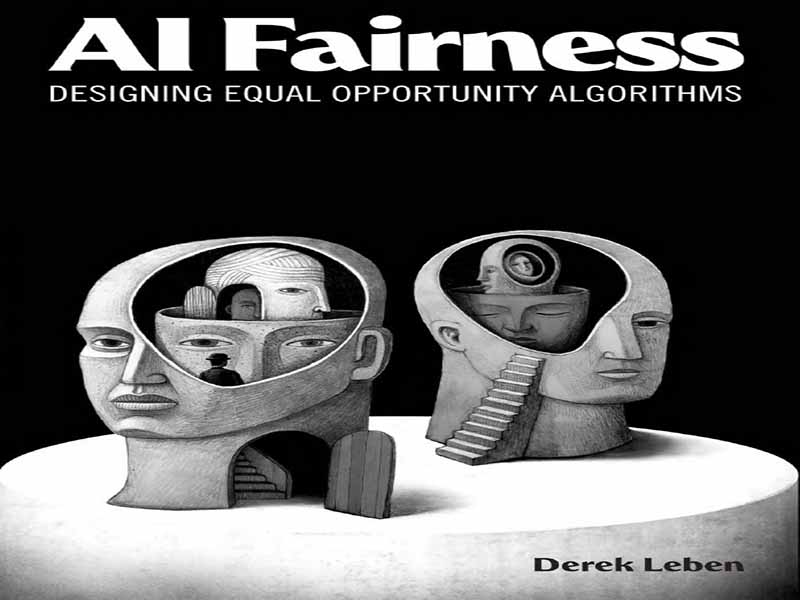- عنوان کتاب: AI Fairness Designing Equal Opportunity Algorithms
- نویسنده: Richard Boateng, Sheena Lovia Boateng
- حوزه: اخلاق در هوش مصنوعی
- سال انتشار: 2025
- تعداد صفحه: 241
- زبان اصلی: انگلیسی
- نوع فایل: pdf
- حجم فایل: 1.28 مگابایت
تصمیمگیری در مورد کالاهای اجتماعی مهم مانند آموزش، اشتغال، مسکن، وام، مراقبتهای بهداشتی و عدالت کیفری، همگی با کمک سیستمهای هوش مصنوعی به طور فزایندهای خودکار میشوند. اما از آنجا که سیستمهای هوش مصنوعی بر اساس دادههایی با نابرابریهای تاریخی آموزش دیدهاند، بسیاری از این سیستمها نتایج نابرابر برای اعضای گروههای محروم ایجاد میکنند. چندین سال است که محققانی که سیستمهای هوش مصنوعی را طراحی میکنند، علل نابرابریها در تصمیمات هوش مصنوعی را بررسی کرده و تکنیکهایی را برای کاهش آنها پیشنهاد دادهاند. معلوم میشود که در واقعبینانهترین شرایط، اعمال برابری در تمام معیارها به طور همزمان غیرممکن است. به همین دلیل، شرکتهایی که از سیستمهای هوش مصنوعی استفاده میکنند باید انتخاب کنند که کدام معیار را معیار صحیح انصاف میدانند و این انتخاب را با دلایل اخلاقی خوب توجیه کنند. این کتاب با استفاده از نظریههای فلسفی سنتی انصاف، چارچوبی برای ارزیابی این استانداردها و اندازهگیریها ایجاد خواهد کرد که میتوان آن را نظریه عدالت الگوریتمی نامید. این نظریه از نظریه عدالت توسعه یافته توسط فیلسوف آمریکایی جان رالز الهام گرفته شده است، اما شامل برخی واگراییهای اساسی است. توصیههای عملی این نظریه عبارتند از: • سیستمهای هوش مصنوعی باید از حداقل سطح دقت قابل قبولی برخوردار باشند. • سیستمهای هوش مصنوعی باید قادر به ارائه فهرستی از مهمترین ویژگیهای علّی در مدل باشند تا تأیید کنند که این ویژگیها شامل ویژگیهای نامربوط (بهویژه ویژگیهای محافظتشده) نیستند و تحت کنترل عامل قرار میگیرند. • سیستمهای هوش مصنوعی باید کاهش یابند تا نرخهای تأیید یکسانی را برای نامزدهای واجد شرایط صرف نظر از عضویت در گروههای محافظتشده فراهم کنند. • سیستمهای هوش مصنوعی باید کاهش یابند تا نرخهای تأیید یکسانی را در بین گروههای محافظتشده فراهم کنند، مگر اینکه طراحان بتوانند نشان دهند که انجام این کار باعث میشود مدل از حداقل استاندارد یا رویههای پیشفرض انسانی دقیقتر نباشد. بخش عمدهای از کتاب شامل بررسی دقیق مفاهیمی مانند «حداقل دقت قابل قبول» و «ویژگیهای مرتبط» و همچنین چگونگی تطبیق این پیشنهادها با هنجارهای فعلی صنعت و مقررات قانونی خواهد بود.
Decisions about important social goods like education, employment, housing, loans, health care, and criminal justice are all becoming increasingly automated with the help of AI systems. But because AI systems are trained on data with historical inequalities, many of these systems produce unequal outcomes for members of disadvantaged groups. For several years now, researchers who design AI systems have investigated the causes of inequalities in AI decisions and proposed techniques for mitigating them. It turns out that in most realistic conditions it is impossible to enforce equality across all metrics simultaneously. Because of this, companies using AI systems will have to choose which metric they think is the correct measure of fairness and justify this choice with good ethical reasons. This book will draw on traditional philosophical theories of fairness to develop a framework for evaluating these standards and measurements, which can be called a theory of algorithmic justice. The theory is inspired by the theory of justice developed by the American philosopher John Rawls, but it involves some substantial divergences. The practical recommendations of the theory will be: • AI systems must have a minimally acceptable level of accuracy. • AI systems must be capable of providing a list of the most significant causal features in the model to validate that these features do not include irrelevant attributes (especially protected attributes) and do fall under agent control. • AI systems must be mitigated to provide equal rates of approval for qualified candidates regardless of membership in protected groups. • AI systems must be mitigated to provide equal rates of approval across protected groups, unless the designers can demonstrate that doing so would make the model less accurate than the minimal standard or default human practices. Much of the book will involve careful investigation of concepts like “minimal acceptable accuracy” and “relevant features,” as well as how these proposals fit within current industry norms and legal regulations.
این کتاب را میتوانید از لینک زیر بصورت رایگان دانلود کنید:
Download: AI Fairness Designing Equal Opportunity Algorithms



































نظرات کاربران